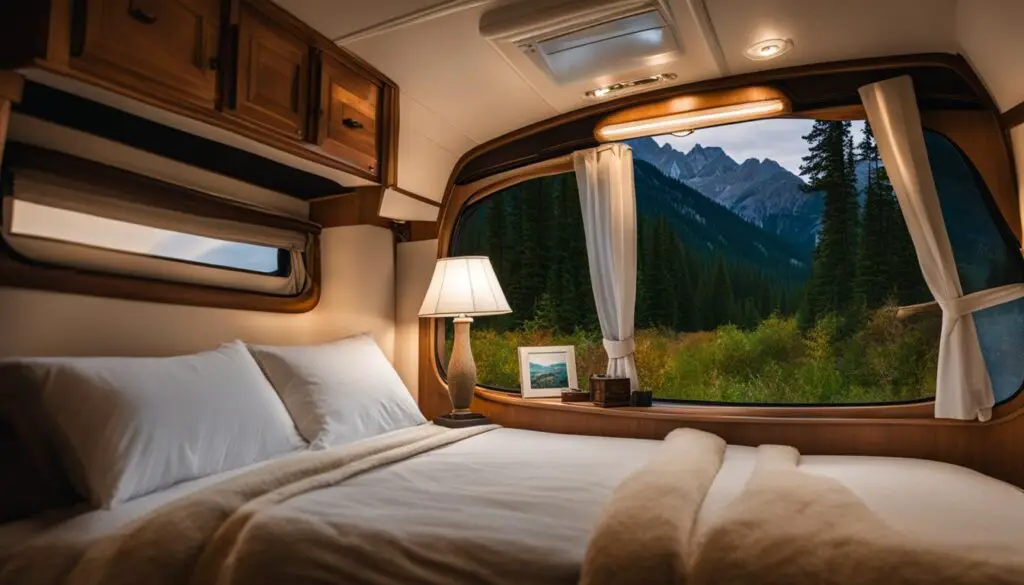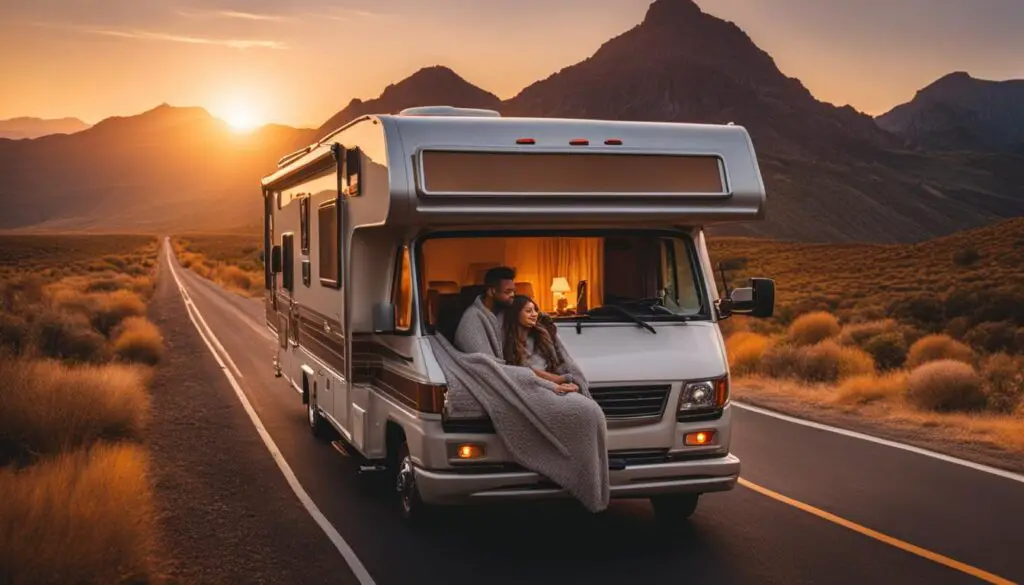If you’re planning a long-distance trip in your RV, you might wonder if it’s safe for passengers to sleep while on the road. Is it legal? Are there any risks involved? In this article, we’ll explore these questions and more to help you understand the ins and outs of allowing passengers to sleep in an RV while driving.
Key Takeaways:
- It’s important to understand the safety implications of sleeping in an RV while driving.
- Legal regulations regarding sleeping in an RV while driving vary by state and jurisdiction.
- There are tips and strategies to make sleeping in an RV while driving more comfortable and safe.
- RV sleeping arrangements can be optimized to accommodate passengers who wish to sleep while driving.
- Alternative solutions to sleeping in an RV while driving are available.
Safety Considerations When Sleeping in an RV While Driving
While RV travel can be a comfortable and convenient way to explore the country, it is important to consider the potential safety risks of allowing passengers to sleep while the vehicle is in motion. The safety of all passengers should always be the top priority while on the road.
One of the biggest risks of sleeping in an RV while it is moving is the possibility of injury in the event of an accident. Passengers who are not properly secured in a seatbelt or other restraint may be at a higher risk of injury during a collision. Additionally, unsecured items in the RV can become dangerous projectiles in the event of a sudden stop or impact.
It is important to note that while sleeping in an RV while it is in motion is legal in some states, it is not legal in all states. Passengers should familiarize themselves with the laws in each state they will be traveling through to ensure compliance.
To ensure the safety of all passengers while sleeping in an RV while driving, consider the following tips:
- Ensure that all passengers are properly and securely restrained during travel.
- Secure all loose items in the RV to prevent them from becoming dangerous projectiles.
- Limit driving time to ensure that the driver is alert and focused while on the road.
- Take frequent breaks to allow everyone in the RV to stretch their legs and refresh their minds.
- Consider alternative sleeping arrangements such as designated rest stops, RV parks, or hotels where passengers can sleep safely and comfortably.
Remember, the safety of all passengers is the top priority while on the road. Even if sleeping in an RV while driving is legal in some states, it is important to take all necessary precautions to ensure the safety and wellbeing of all travelers.
Legal Regulations for Sleeping in an RV While Driving
Before you decide to let your passengers sleep in an RV while in motion, it is important to know the regulations around it. While laws vary by state, there are some general guidelines to follow to ensure compliance with the law.
Rules and Restrictions
Firstly, it is important to note that the driver of the RV should not be sleeping while driving. It is illegal and can lead to dangerous situations. Passengers, on the other hand, can usually sleep in the RV while it is in motion as long as they are wearing seat belts. Regulations for sleeping in an RV while driving may involve seat belt laws and child restraint laws, which can vary by state and by the age of the passengers.
Safety and Liability
It is important to consider the safety and liability implications of allowing passengers to sleep in an RV while it is in motion. The driver may be held responsible for any accidents or injuries that occur if they knowingly let passengers violate safety regulations. Additionally, there may be liability issues if the sleeping arrangements are not secure, leading to injury or property damage.
“Passengers, on the other hand, can usually sleep in the RV while it is in motion as long as they are wearing seat belts.”
Compliance with Regulations
To ensure compliance with regulations for sleeping in an RV while driving, it is important to research the laws in your state and any states you may be traveling through. Be sure to secure sleeping areas properly and provide adequate safety restraints for passengers. By following the rules and regulations, you can enjoy a safe and peaceful journey with passengers able to catch up on some rest.
Tips for Comfortable Sleep in an RV While Driving
Traveling in an RV can be an exciting and adventurous experience, but getting a good night’s rest while on the road can be tricky. To help ensure that you’re comfortable and refreshed during your journey, here are some essential tips for sleeping in an RV while driving:
- Invest in a quality mattress: A comfortable mattress is key to a good night’s sleep. Look for one that provides the right balance of support and comfort, and consider adding a foam mattress topper for extra cushioning.
- Choose the right sleep position: The sheer size of an RV means that there are several sleeping position options available, including sideways, diagonally, or lengthways. Experiment to find out what works best for you.
- Block out light and noise: Large windows and thin walls mean that RVs can be susceptible to noise and light disturbances. Consider investing in blackout curtains or a sleep mask to block out light and earplugs or noise-cancelling headphones to reduce noise.
- Stay cool: Temperature regulation is crucial for a peaceful sleep. Make sure your RV has adequate ventilation or invest in a portable fan to create a cool, comfortable sleeping environment.
- Take breaks: While it’s possible to sleep while driving in an RV, it’s always best to take regular breaks. Not only will it help you feel more refreshed, but it’s also safer and helps prevent driver fatigue.
By following these tips, you can ensure that you’re well-rested and prepared to tackle your next adventure on the road. Don’t let a lack of sleep dampen your journey!
RV Sleep Options Table
| Option | Description |
|---|---|
| Sideways | Sleeping sideways across the RV bed provides good support for your back and can be more comfortable for couples who want to share a bed. |
| Diagonally | Sleeping diagonally provides the most space for solo sleepers, but it can be less comfortable for couples sharing a bed. |
| Lengthways | Sleeping lengthways allows for the most natural sleeping position for most people and can be a good option for those who have a lot of height. |
| Bunk Beds | Bunk beds are perfect for families or groups traveling together; they offer individual space and privacy. |
| Convertible Dinette | This option allows you to convert the dinette table into a bed, providing extra sleeping space for guests. |
RV Sleeping Arrangements for Passengers
Traveling long distances can be tiring. Passengers may want to sleep while driving in an RV to avoid exhaustion. In this section, we will explore different sleeping arrangements and setups that can optimize comfort and convenience for passengers.

Types of RV Sleeping Arrangements
RVs offer a variety of options for sleeping arrangements that cater to passenger needs. Some popular choices include:
- Bunk beds: RVs with multiple levels of bunk beds to accommodate families or groups of passengers.
- Sofa beds: Comfortable couches that can fold out into a bed.
- Dinette beds: Seating areas that can be converted into a sleeping space.
- Overhead cab beds: Beds located above the driver and passenger seats.
Some RVs offer a combination of these features, making it easier for passengers to choose an arrangement that best suits their needs.
Optimizing RV Sleeping Space
Optimizing space is crucial when it comes to RV sleeping arrangements. Passengers can make their sleeping experience more comfortable by:
- Choosing appropriate bedding to enhance comfort and provide warmth.
- Keeping sleeping areas clutter-free to maximize space and reduce safety hazards.
- Securing personal items to prevent them from falling or sliding while driving and affecting the passengers’ sleep.
Taking these simple steps can help to improve the quality of sleep while driving in an RV.
Safety Precautions for Sleeping Passengers in RVs
While sleeping in an RV can be a convenient and comfortable way to travel long distances, it is important to take precautions to ensure the safety of passengers while on the road.
Can you sleep in an RV without stopping? is a common question asked by many, but it is crucial to understand that there are potential risks and hazards associated with sleeping while driving in an RV that should not be overlooked. These risks include sudden stops, collisions, and the risk of ejection if the bed area is not secured properly. Therefore, passengers must take steps to secure themselves and minimize potential hazards.
Secure Sleeping Areas
One of the most important safety precautions to take when sleeping in an RV is to secure sleeping areas. This involves ensuring that the bed area is enclosed and that passengers are secured correctly. Passengers should ensure that their seat belts are always fastened while the RV is in motion, and the bed area should contain safety rails to help keep passengers in place.
Designated Sleeping Areas
It is essential to ensure that designated sleeping areas are established in an RV. This means that passengers should only sleep in areas specifically designed for that purpose and not on the couch or the dinette table. Additionally, mattresses and bedding should be appropriately secured to prevent any sudden movements during travel.
The following table outlines specific safety precautions to help guarantee the safety of passengers while sleeping in an RV:
| Precautions | Why It Matters |
|---|---|
| Use designated sleeping areas only | Prevents passengers from injury in case of an accident |
| Secure the bed area with safety rails | Prevents ejection or sudden movements due to braking |
| Fasten seat belts always | Reduces the risk of injury during sudden stops or collisions |
| Ensure mattresses and bedding are appropriately secured | Prevents any sudden movements during travel |
By following these safety precautions, sleeping in an RV while driving can be a safe and comfortable travel option for passengers. It is crucial to prioritize safety when traveling in an RV to ensure that everyone enjoys the journey without incident.
Benefits of Allowing Passengers to Sleep in an RV While Driving
There are several benefits to allowing passengers to sleep in an RV while on the move. One of the most significant advantages is the comfort factor. RVs have ample sleeping space, and passengers can stretch out and get a good night’s sleep even while traveling long distances.
Another benefit of an RV is the convenience factor. Passengers can sleep and wake up in a new location without the need to find a hotel, saving both time and money. This convenience allows for more flexibility in travel plans and the ability to explore more destinations.
Moreover, sleeping in an RV while driving provides passengers with privacy. Unlike commercial travel options, such as planes or trains, passengers have their own sleeping areas and do not need to share it with anyone else. This privacy allows for a more comfortable and peaceful sleep experience.
Another advantage of sleeping in an RV while on the move is the ability to wake up to beautiful scenery. Passengers can park their RV in scenic locations and wake up to a beautiful view and fresh air. This experience is not possible when sleeping in a hotel room or other indoor accommodations.
Overall, allowing passengers to sleep in an RV while driving can provide a comfortable, convenient, and flexible travel experience. It also enables passengers to explore more locations while saving money on accommodation.

Alternatives to Sleeping in an RV While Driving
If you are not comfortable sleeping in an RV while it’s in motion, there are alternatives available. Here are a few to consider:
Designated Rest Stops
Designated rest stops are available along highways and interstates for drivers to take a break and rest. These stops provide facilities such as restrooms, picnic tables, and vending machines for travelers to relax and recharge. Take advantage of these rest stops for a refreshing break when on a long road trip.
RV Parks
RV parks offer a variety of amenities, including parking spots, electricity, water, and Wi-Fi access, making them a popular choice for RV travelers. Stay overnight and take advantage of features such as swimming pools, playgrounds, and other recreational activities.
Overnight Accommodations
If you prefer to sleep in a traditional accommodation, look for hotels, motels, and lodges on your route. Book in advance for a comfortable stay that includes all the amenities you need. Plus, you can rest easy knowing you won’t have to worry about any safety regulations.
Ultimately, the choice of where and how to rest while on a long RV road trip is up to the individual traveler. Consider all the options available and choose what works best for you and your fellow travelers.
Conclusion
After exploring the safety and legality of sleeping in an RV while driving, it’s clear that precautions need to be taken to ensure the well-being of all passengers. While it may seem tempting to catch some Z’s while on the road, it’s crucial to prioritize safety above all else.
By following the regulations and implementing safety measures such as secured sleeping areas and designated rest stops, passengers can enjoy a comfortable and convenient travel experience. However, for those who prefer not to sleep in a moving vehicle, there are alternative solutions available such as RV parks and overnight accommodations.
In conclusion, whether you choose to sleep while driving in an RV or not, the key is to prioritize safety and compliance with legal regulations to ensure a hassle-free journey for everyone.
FAQ
Can passengers sleep in an RV while driving?
While it is not recommended for passengers to sleep in an RV while driving, it is technically possible. However, there are safety considerations and legal regulations to be aware of.
What are the safety considerations when sleeping in an RV while driving?
Sleeping in an RV while driving poses certain risks, such as not being properly restrained during sudden stops or accidents. It is important to secure sleeping areas and ensure passengers are buckled up when the vehicle is in motion.
What are the legal regulations for sleeping in an RV while driving?
The legal regulations for sleeping in an RV while driving can vary by jurisdiction. It is important to research and comply with the specific rules and restrictions of the areas you will be traveling through.
What are some tips for comfortable sleep in an RV while driving?
To achieve a comfortable sleep experience in an RV while driving, consider using sleep aids like eye masks and earplugs, investing in a quality mattress, and creating a designated sleeping area with proper ventilation and temperature control.
What are the different RV sleeping arrangements for passengers?
RV sleeping arrangements can vary depending on the size and layout of the vehicle. Common options include bunk beds, fold-out sofas, convertible dinettes, and dedicated sleeping compartments. It is important to optimize the sleeping space for maximum comfort and convenience.
What safety precautions should be taken for sleeping passengers in RVs?
For the safety of sleeping passengers in RVs, ensure they are properly secured with seat belts or harnesses and that sleeping areas are equipped with safety features like guardrails or barriers to prevent falls or movement during transit.
What are the benefits of allowing passengers to sleep in an RV while driving?
Allowing passengers to sleep in an RV while driving offers comfort, convenience, and flexibility during long journeys. It allows for continuous travel without the need for frequent rest stops or overnight stays.
Are there alternatives to sleeping in an RV while driving?
If sleeping in an RV while driving is not an option, there are alternatives available. Consider stopping at designated rest stops, RV parks, or overnight accommodations along your route to ensure a restful sleep experience.
What is the conclusion regarding sleeping in an RV while driving?
While it is technically possible, sleeping in an RV while driving is not recommended due to safety concerns. It is important to prioritize the well-being of passengers and comply with legal regulations to ensure a safe and enjoyable journey.
